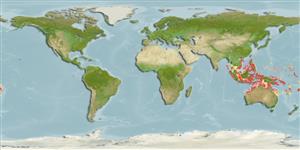Actinopterygii (ray-finned fishes) >
Beryciformes (Sawbellies) >
Holocentridae (Squirrelfishes, soldierfishes) > Holocentrinae
Etymology: Sargocentron: Greek, sargos = sargus + Greek, kentron = sting (Ref. 45335).
Environment / Climate / Range
Ecology
Marine; brackish; reef-associated; depth range 6 - 40 m (Ref. 90102). Tropical, preferred ?; 20°N - 25°S
Western Pacific: Indonesia (including Mentawai Islands), Philippines, Solomon Islands, and Great Barrier Reef. Also reported from Malaysia (Ref. 5756), Tosa Bay, Japan (Ref. 559), and Viet Nam (Ref. 9706).
Size / Weight / Age
Maturity: Lm ? range ? - ? cm
Max length : 27.0 cm TL male/unsexed; (Ref. 48635)
Dorsal
spines
(total): 11;
Dorsal
soft rays
(total): 12-13;
Anal
spines: 4;
Anal
soft rays: 9. Stripes black to red above, with thin white interspaces. Black peduncular blotch and additional blotches at soft dorsal and anal fin bases that vary greatly in size between individuals or habitats. Large spine in anal fin blue (Ref. 48635). Alternating broad deep red and narrow silvery stripes on body. 1-6 spinules on posterior edge and 0-1 on anterior of nasal fossa. Preopercular spine 3/4 to nearly equal to orbit diameter. Four (4) oblique rows of scales on cheek. Body depth 2.7-3.0 in SL; head length 2.8-3.0 in SL; snout length 4.4-4.85 in head length; interorbital width 4.3-4.7 in head length; premaxillary groove extending slightly posterior to a vertical at anterior edge of orbit; anterior end of nasal bone ending in short spine that angles laterally; medial margin of nasal bone without spinule; 1-6 spinules at posterior edge of nasal fossa, 0-1 at anterior edge; upper edge of first suborbital bone with a laterally projecting spine near a vertical at the front edge of orbit, followed by a serrated ridge; preopercular spine varying from 3/4 to nearly equal to orbit diameter, 2.85-3.5 in head length; longest dorsal spines 3rd or 4th, 1.8-2.0 in head length; third anal spine 1.1-1.3 in head length (Ref. 27370).
Inhabits coral-rich areas of outer reef slopes and drop-offs to depths greater than 40 m (Ref. 9710). Hides in caves or beneath ledges by day; forage for food at night, mainly on benthic crabs and shrimps. Spine of preopercle venomous.
Life cycle and mating behavior
Maturity | Reproduction | Spawning | Eggs | Fecundity | Larvae
Randall, J.E., 1998. Revision of the Indo-Pacific squirrelfishes (Beryciformes: Holocentridae: Holocentrinae) of the genus Sargocentron, with descriptions of four new species. Indo-Pac. Fish. (27):105 p. (Ref. 27370)
IUCN Red List Status (Ref. 115185)
CITES (Ref. 94142)
Not Evaluated
Human uses
More information
Common namesSynonymsMetabolismPredatorsEcotoxicologyReproductionMaturitySpawningFecundityEggsEgg development
ReferencesAquacultureAquaculture profileStrainsGeneticsAllele frequenciesHeritabilityDiseasesProcessingMass conversion
Tools
Special reports
Download XML
Internet sources
Estimates of some properties based on models
Phylogenetic diversity index (Ref.
82805): PD
50 = 0.5000 [Uniqueness, from 0.5 = low to 2.0 = high].
Bayesian length-weight: a=0.01622 (0.00784 - 0.03354), b=2.97 (2.80 - 3.14), in cm Total Length, based on LWR estimates for this Genus-body shape (Ref.
93245).
Trophic Level (Ref.
69278): 3.6 ±0.59 se; Based on food items.
Resilience (Ref.
69278): High, minimum population doubling time less than 15 months (Preliminary K or Fecundity.).
Vulnerability (Ref.
59153): Low vulnerability (21 of 100) .
